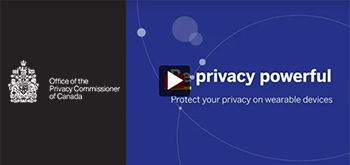Wearable devices and your privacy
Revised: January 2024
Easy steps such as reading privacy policies and using strong privacy settings can help you protect privacy when using wearable devices such as fitness trackers.
Wearable technologies such as fitness trackers and smart watches have become commonplace. Other products with potential privacy implications are regularly being rolled out. For example:
- a video camera disguised as a shirt button
- a temporary tattoo that senses sleep patterns, heart rate and stress levels
- a medication-monitoring machine that can be swallowed like a cookie crumb
As useful as wearable devices may be, they can raise issues for the privacy of both users and those around them. These issues are important to consider as wearable computing becomes an even more prominent feature of our daily lives.
Wearable devices collect data about you and your condition, activities and day-to-day choices. They may also record other people. This information can be processed, interpreted, aggregated, stored and shared with others.
This information could also potentially be of interest to a boss, or an insurance company. It could wind up being used in a way that you did not anticipate. Meanwhile, small, concealed cameras can record other people without their knowledge. Potentially damaging images could be uploaded to the Internet for public view.
Here are some simple tips to help you protect privacy while enjoying the benefits of wearable technologies.
Tips to protect your privacy:
- Read the privacy information before you buy
- Make privacy one of the features you evaluate before you buy.
- Check the manual for whether the device requires you to take a step, such as press a button and/or enter a password, to initiate pairing with another device, such as your smart phone. If it does not, that creates a privacy risk because the device will constantly auto search to pair with another device and anyone within range could potentially connect with and read the data on your device.
- Check the company’s privacy information to find out about what personal information will be collected and how it will be used and shared. Are you comfortable sharing this personal information? Is it shared with third parties? How long is personal data retained? Ask questions if the company’s information is incomplete or unclear. If you are not comfortable with the information you receive from the company, you may wish to reconsider using their service.
- Does the manufacturer state that it follows any security or privacy standards or certifications? A number of organizations, including the International Standards Organization (ISO), and the National Institute of Standards and Technology (NIST) have developed industry standards.
- Remember, new wearable technologies enter the market all the time. Do your research and think carefully about whether the trade of personal information is worth the claim made by the manufacturer.
- Choose strong privacy settings
- If your wearable device can be configured, choose settings that maximize privacy. Less data collected in the first place equals less data available to third parties down the road.
- If your device allows you to share your information with others, via social media for example, consider who would potentially be able to see that information.
- Review your privacy settings regularly.
- Use a password
- Wearable devices often link to your smart phone, so it is important to protect your phone with passwords, user authentication and other security features. Use strong passwords and do not re-use the same password for different websites, accounts and devices or disclose these to others.
- Turn off your device
- Control the amount of personal data collected by shutting down your device when you are not using it.
- If required to wear a tracking device at work, deactivate it at the end of the work day.
- Accept updates
- Update operating systems and apps to ensure that you have the latest security features.
- Respect the privacy of others
- Consider the potential implications of recording others, especially without their knowledge. Seek permissions before sharing video of other people.
- Ensure old devices are wiped of personal information
- If you no longer need a device, make sure that all personal information is permanently removed before you throw it away. Be aware that this may involve more than just resetting a device to factory settings. Check with the device manufacturer. In the event that there is no method for wiping the device, you could destroy the memory chip.
Related video

View the video related to these tips
Related infographic
- Date modified:

